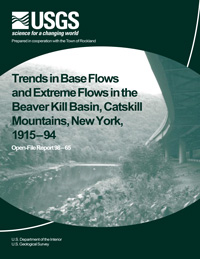 Trends in Base Flows and Extreme Flows in the Beaver Kill Basin, Catskill Mountains, New York, 1915-94
Trends in Base Flows and Extreme Flows in the Beaver Kill Basin, Catskill Mountains, New York, 1915-94
by Barry P. Baldigo
U.S. GEOLOGICAL SURVEY
Open-File Report 98-65
ABSTRACT
Long-term records from five streamflow-gaging
stations within and near the 300-square mile Beaver
Kill Basin were analyzed to determine whether
construction and presence of New York State Route 17
(NY 17), which was completed in the late 1960's,
could have altered hydrologic processes in the basin
and thereby adversely affected the basin's trout
populations. The hypothesis investigated is that NY 17
has altered surface-water and shallow ground-water
flowpaths where it parallels the stream and has
increased runoff rates and thereby (1) increased the
range in stream discharge (prolonged the base flows,
decreased the low flows, and increased the high flows),
and (2) altered stream-channel morphology through
increased volume and velocity of stormflows.
Analyses of base flows, discharge-duration curves,
stage-to-discharge relations, peak and bankfull
discharges, and flow extremes at a downstream
(Beaver Kill at Cooks Falls) and a small tributary
(Little Beaver Kill at Livingston Manor) site provide
only limited evidence that NY 17 affected hydrologic
processes within the basin. These effects are best
indicated by significant increases in the magnitude and
(or) the frequency of moderate to large discharges
(exceedence probabilities) on an instantaneous basis at
the Beaver Kill at Cooks Falls site after 1965.
Increases in stormflows can not be attributed solely to
NY 17, however, because the trend was evident long
before NY 17 was constructed. Changes in land use in
parts of the watershed may have contributed to gradual
and continuous increases in stormflows throughout the
entire 80 (plus) years of record.
Changes in most base-flow and low-flow statistics
for the downstream (Beaver Kill at Cooks Falls) site
after 1965 are not statistically significant, but, changes
in flow-duration curves and annual peak flows are
evident. Flow-duration curves at this site indicate that
there is a 16 percent increase in average daily flows
after 1965. Annual peak flow data indicate that peak
flows from storms recurring at 2-year (and longer)
intervals after 1965 are significantly larger than those
that recur at the same frequencies before 1965. The
lack of comparable increases in peak flows from
several nearby reference sites after 1965 indicate that
the observed increases in peak flows may be unique to
the Beaver Kill Basin.
Flow-duration curves and many base-flow and
high-flow statistics for the small tributary paralleled by
NY 17 in the in the upper reaches of the basin (Little
Beaver Kill at Livingston Manor) appear to be
considerably altered since NY 17 was constructed.
Flow-duration curves at this site indicate that there is
about a 54 percent increase in average daily flows after
1965. Increases in the ratio of average annual base
flow to average annual flow until 1965 then
subsequent decreases suggest an extreme affect of NY
17 on hydrology of the subbasin. The effect of NY 17
on hydrology of the Little Beaver Kill subbasin cannot
be defined with certainty, however, because the flow
record after 1965 is too short; discharge monitoring
was discontinued in 1981.
The increases in peak stormflows in the lower
Beaver Kill basin through the period of record may
have increased the rates of bed-sediment erosion
(degradation) and deposition and accelerated changes
in stream-channel morphology, however, these
possible effects were not examined. Suggestions for
further investigation of the effects of NY 17 and of
other factors on hydrology, channel morphology, fish
habitat, and fish populations in the Beaver Kill Basin
include (1) addition of streamflow gages or a creststage
gage network at critical locations, (2) a review of
engineering records and other aerial photographs for
indications of changes in channel morphology, (3)
compilation of temperature data and modeling spatial
extent and magnitude of stressful summer
temperatures (to selected trout species), and (4)
confirming the extent and severity of toxic thermal
episodes using in-situ fish toxicity tests.
Citation: Baldigo, B.P., 1998, Trends in base flows and extreme flows in the Beaver Kill Basin, Catskill Mountains, New York, 1915-94: U.S. Geological Survey Open-File Report 98-65, 17 p.
 [Full Report, Acrobat PDF
(278K)]
[Full Report, Acrobat PDF
(278K)]
[an error occurred while processing this directive]
|
